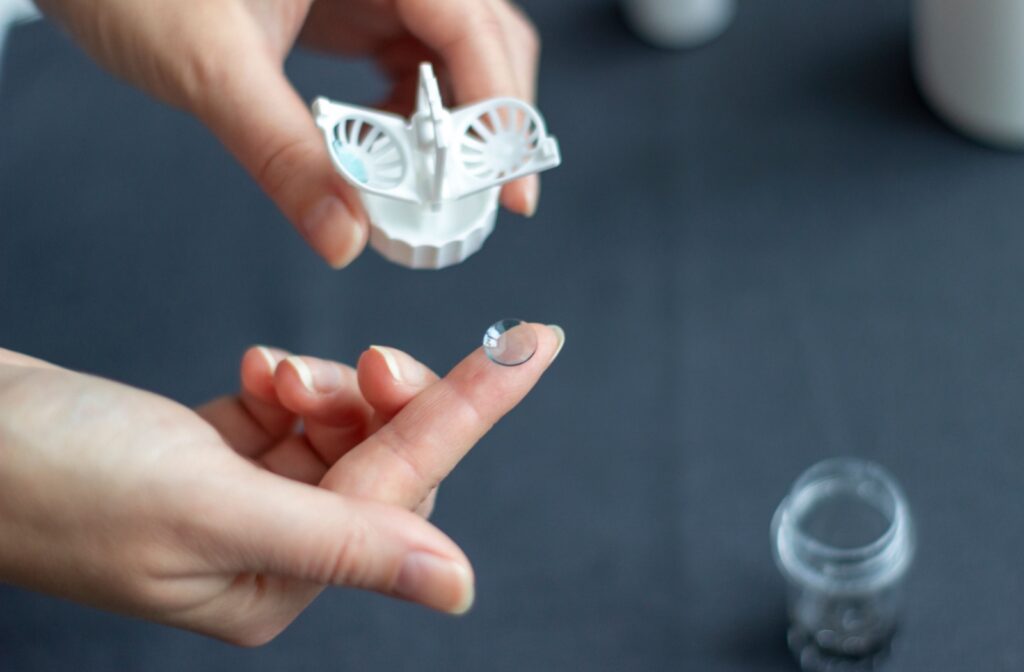Myopia, commonly known as nearsightedness, is a vision issue that affects a growing number of children worldwide. Higher levels of myopia can increase the risk of developing serious eye conditions later in life, so early management is a crucial step.
At Total Vision Chino Hills, ortho‑k lenses are one of the options available to help manage myopia progression in children. Ortho-k is a non-surgical treatment that gently reshapes the cornea overnight to improve vision during the day and slow the progression of myopia.
What Is oOrtho‑k & How Does It Work?
Ortho‑k lenses are rigid gas-permeable contact lenses worn overnight. While your child sleeps, these lenses gently reshape the cornea (the front surface of the eye), allowing for clear, glasses-free vision during the day.
Here’s how it works:
- Gentle Reshaping: ortho‑k lenses temporarily flatten the central cornea by a few micrometers.
- Light Refocused: This subtle change helps redirect how light enters the eye, improving focus and reducing the visual triggers that contribute to myopia progression.
- Temporary & Reversible: If your child stops wearing the lenses, the cornea gradually returns to its original shape.
Benefits for Children
Research studies, particularly those from locations such as Hong Kong, have demonstrated that ortho‑k can slow myopia by roughly 50 percent compared to children wearing no corrective lenses or standard prescription lenses . The lenses allow clear vision during the day without the need for glasses or contacts, which can boost a child’s independence and confidence.
Moreover, by addressing myopia progression early, ortho‑k may reduce the chances of higher prescriptions and related risks, like retinal detachment, cataracts, or glaucoma later in life. Stabilizing vision during key years of growth could therefore play a protective role long‑term.
Comparing Ortho‑k with Other Methods
While ortho‑k is a powerful option, it’s not the only one. Parents may also consider:
- Low-dose atropine eye drops: These drops slow eye growth by targeting chemical signals in the eye. They’re effective, but may cause light sensitivity and require daily use.
- Soft multifocal or peripheral-defocus contact lenses: Worn during the day, these lenses alter how light hits the retina—similar to ortho‑k, but without reshaping the cornea.
Each method has pros and cons. Ortho‑k stands out as a non-pharmaceutical, glasses-free solution that works while your child sleeps.
What the Treatment Looks Like
A typical ortho‑k journey begins with specialist fitting. Precise corneal mapping allows practitioners to design custom lenses tailored to a child’s eye shape. Families are trained in lens care (cleaning, storing, inserting, etc.) to maintain hygiene and reduce risk. Regular follow‑up visits are key to monitor changes in vision, corneal health, and lens fit .
Initial adaptation takes time, some children may notice visual distortions like glare or ghosting at night during the first few weeks. These effects usually resolve as the eye adjusts .
Once the cornea responds, the corrected shape can sustain clear vision for most of the day. Regular lens wear, typically nightly, helps maintain it. Some families may find occasional short gaps in usage are acceptable, though consistent patterns are generally recommended.
Potential Risks & Considerations
Ortho‑k is generally safe when prescribed and monitored by experienced professionals. However, as with any overnight lens wear, risks, though rare, can include:
- Eye infections (e.g., microbial keratitis), especially with poor hygiene
- Temporary side effects, such as dry eyes or night glare
- Limited suitability for children with very high prescriptions, irregular corneas, or dry eye conditions
Ortho‑k is not suitable for every child. Factors such as extreme refractive error (beyond around –6 diopters), corneal shape irregularities, or dry eye may limit success . A thorough eye examination and candid consultation can help determine if the approach is appropriate.

Family Commitment & Practical Matters
Since lenses are worn at night, parents play an essential role in overseeing lens insertion and removal, ensuring cleanliness and monitoring comfort. Initial follow‑up visits are frequent, often spaced several weeks apart, gradually moving to check‑ins every few months once stability is established .
There is also a financial component: ortho‑k lens sets, fittings, follow‑ups, and replacements can require a higher upfront investment compared to glasses. Yet when viewed as a long‑term strategy to slow myopia, and potentially lower the risk of high‑myopia complications over time, the benefits may outweigh the costs.
Is Ortho‑k the Right Path for Your Family?
Deciding on ortho‑k involves balancing expectations, lifestyle, and eye health goals. Families should seek optometrists or eye‑care teams experienced in pediatric ortho‑k and myopia control that use evidence‑based methods, corneal imaging, and proactive follow‑ups.
ortho‑k doesn’t appeal to every situation. Some children may prefer glasses or daytime soft lenses. Others may explore atropine drops or digital‑behavior changes (like increased outdoor time). A well‑informed plan might include more than one approach.
Ortho-k at Total Vision
Families interested in exploring ortho‑k should seek a comprehensive eye exam that includes corneal mapping, discussion of treatment expectations, and a clear understanding of routine care. Trends in pediatric myopia continue to show a global increase; it’s encouraging that safe, reversible options like ortho‑k exist to help guide healthier visual futures for kids.
To learn whether ortho‑k is a good fit for your child’s vision needs, book an appointment with the team at Total Vision today.





